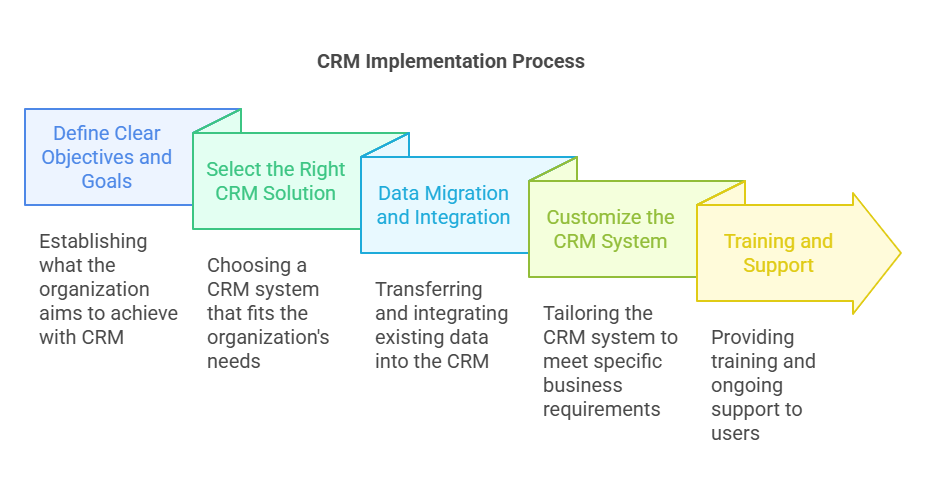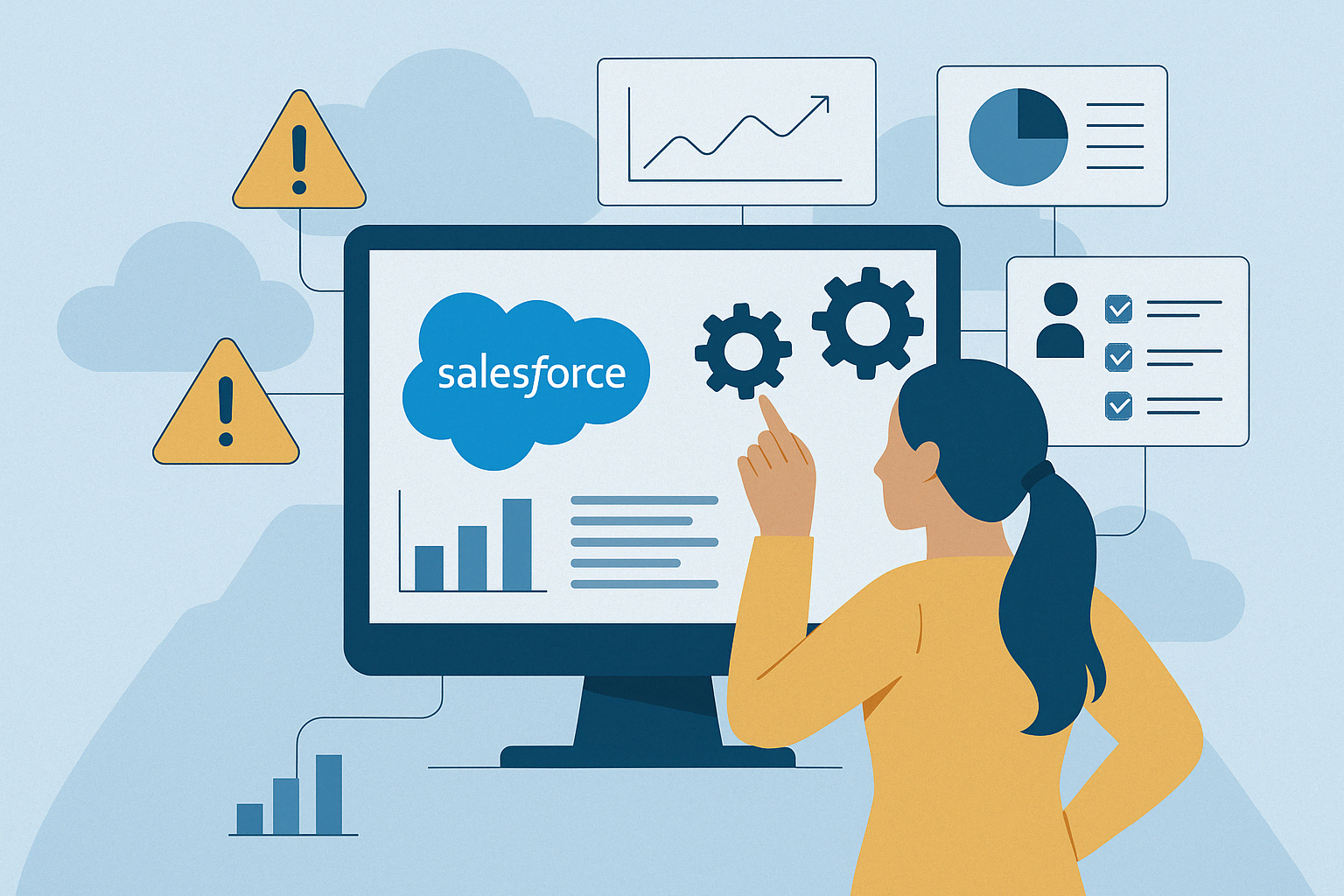 AI Blog Generation – Mass Content at Lightning Speed!
AI Blog Generation – Mass Content at Lightning Speed!
Five Important Steps in CRM Implementation
Written by Harry Johnson » Updated on: June 17th, 2025 141 views

Implementing a Customer Relationship Management (CRM) system is an essential step in optimizing business operations, enhancing customer satisfaction, and driving growth. A well-planned CRM implementation can transform a company's customer interaction management, improve collaboration, and automate processes. Below, we’ll walk through the five important steps to successfully implement a CRM system, with a focus on Salesforce CRM.

1. Define Clear Objectives and Goals
The first step in any CRM implementation is to clearly define your business goals and objectives. Whether you want to improve customer retention, enhance sales productivity, or streamline your customer service operations, understanding what you want to achieve will guide the entire process. These goals should be measurable and aligned with your company’s overall strategic objectives.
For example, you might set goals like:
- Reducing customer churn by 10% in the next year.
- Increasing sales conversions by 15%.
- Automating repetitive tasks to save 20 hours per week for your sales team.
Once you’ve outlined these goals, you’ll have a clear vision of what success looks like for your CRM system and can plan your implementation accordingly.
2. Select the Right CRM Solution
Choosing the right CRM solution is critical to the success of your CRM implementation. The CRM system should meet your specific business needs, integrate well with your existing tools, and scale as your business grows. It’s important to evaluate different CRM options and select one that fits your company’s size, industry, and objectives.
So, if you’ve decided to select Salesforce as your CRM system, you’ve made a great choice. Salesforce is a powerful, flexible platform with robust features for sales, customer service, and marketing teams. It can help automate processes, manage customer interactions, and generate detailed analytics. Salesforce also offers various cloud solutions like Sales Cloud, Service Cloud, and Marketing Cloud, each designed to meet the unique needs of different business functions.
To implement Salesforce effectively, opt for Salesforce Implementation Services. With the help of Salesforce consultants, you can ensure a smooth setup and integration of the platform, making sure that it is customized to your specific business requirements and that your team is fully trained and ready to use it.
3. Data Migration and Integration
Migrating your existing data into the new CRM system is a critical step. Accurate and comprehensive data is the foundation of a successful CRM system, and you must transfer all relevant customer data—such as contact information, sales history, and service requests—into the new system. Ensuring that this data is correctly migrated will help you maintain business continuity and avoid any disruption.
In Salesforce CRM, this step involves importing customer data into the Salesforce system using tools like the Salesforce Data Import Wizard or third-party integration tools. Additionally, you may need to integrate Salesforce with other business systems, such as accounting software, marketing platforms, and ERP systems. These integrations ensure that all business processes are connected, enabling a 360-degree view of the customer.
4. Customize the CRM System
Customization is key to making your CRM system work for your unique business processes. It’s unlikely that an out-of-the-box CRM solution will meet all of your requirements, which is why tailoring the system is crucial.
In general, CRM customization might include:
- Setting up custom fields to track specific data relevant to your business.
- Creating automation rules for lead assignment or case escalation.
- Customizing reports and dashboards to give management real-time insights.
For Salesforce CRM, the customization options are extensive. You can configure Salesforce’s features to match your business workflows, such as creating custom objects to track specific information, setting up automated workflows to streamline operations, and designing personalized reports that reflect your business KPIs. With Salesforce’s flexibility, the CRM becomes a true reflection of your processes and a valuable tool for your team.
5. Training and Support
The final step in CRM implementation is to train your team and provide ongoing support. A CRM system is only as good as the people using it, and proper training ensures that your team is comfortable navigating the platform, using its features, and making the most of its capabilities.
In general, CRM training should cover:
- Basic navigation and functionality.
- How to input and update customer data.
- Best practices for using the CRM to improve customer interactions.
For Salesforce CRM, Salesforce offers a range of training resources, including online courses through Trailhead, Salesforce’s learning platform. You can also work with a Salesforce implementation partner to provide customized training for your team, ensuring that everyone is well-versed in using the platform to its full potential. Continuous support is also vital, so ensure that you have access to resources like Salesforce Help, community forums, and dedicated support from your implementation partner.
Conclusion
CRM implementation is a transformative process that can help streamline operations and enhance customer relationships. By following these five important steps—defining your goals, selecting the right CRM system, migrating data, customizing the system, and training your team—you can ensure a smooth and successful CRM rollout.
If you’re considering Salesforce as your CRM solution, it’s important to partner with a Salesforce Implementation Services provider who can help guide you through each of these steps and ensure that the platform is tailored to meet your business’s needs. With the right strategy and support, your Salesforce CRM implementation will set the foundation for improved customer relationships, streamlined processes, and long-term business success.
Note: IndiBlogHub features both user-submitted and editorial content. We do not verify third-party contributions. Read our Disclaimer and Privacy Policyfor details.
Copyright © 2019-2025 IndiBlogHub.com. All rights reserved. Hosted on DigitalOcean for fast, reliable performance.

















